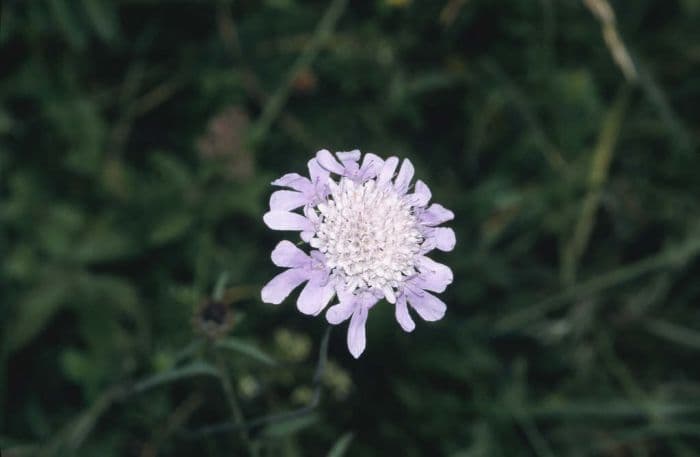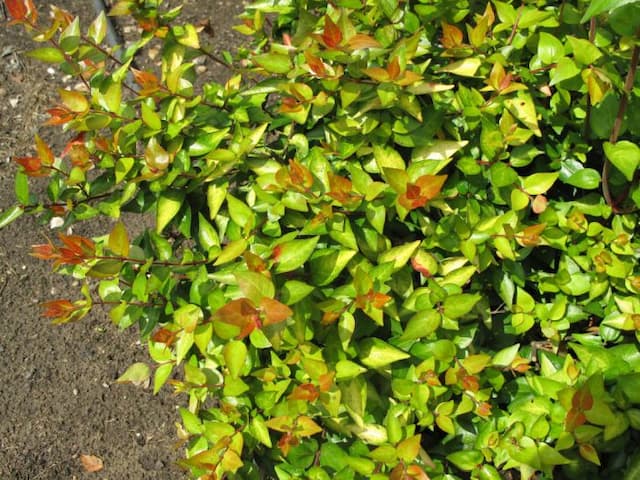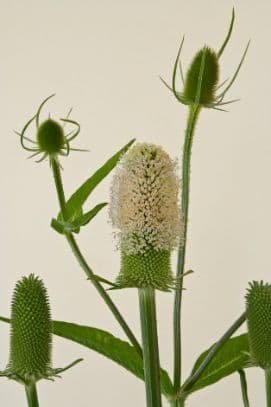Field Scabious Knautia arvensis

ABOUT
The field scabious is a perennial plant known for its distinctive flowers and foliage. The flowers are quite eye-catching, usually in a soft lavender-blue hue, sometimes veering towards a pale purple or pink. They have a pincushion-like appearance, with a multitude of tiny florets tightly packed into a rounded head. These heads are held aloft on slender stems above the foliage. The leaves of field scabious are mostly arranged in a rosette at the base, and they can vary in shape. The basal leaves are usually oblong or spoon-shaped and may have a softly serrated edge, while the upper leaves are divided and can appear more lanceolate or pinnatifid, which means they have a feather-like shape with opposite pairs of lobes. The overall impression of the plant is one of delicate grace, with its pastel flowers swaying on their stems and the soft greenery forming a backdrop. The field scabious exudes a gentle, meadow-like quality, often evoking images of a natural, rustic landscape. Its appearance is such that it attracts a variety of pollinators, enhancing its charm in a garden setting or in the wild.
About this plant
 Names
NamesFamily
Caprifoliaceae
Synonyms
Field Scabious, Bluebuttons, Field Knautia, Gipsy Rose, Harvest Lice, Lady's Cushion, Pin-Cushions, Scabiosa, Sweet Scabious
Common names
Trichera arvensis, Scabiosa arvensis, Knautia kolenatiana, Knautia ressmannii, Knautia dipsacifolia, Knautia longifolia, Knautia sylvatica, Knautia silvatica, Knautia kitaibelii.
 Toxicity
ToxicityTo humans
Field Scabious (Knautia arvensis) is not known to be toxic to humans. There are no common reports of poisoning or adverse effects from ingesting any part of the plant. Therefore, accidental ingestion should not be cause for concern in terms of toxicity.
To pets
Field Scabious (Knautia arvensis) is not known to be toxic to pets, including common animals such as dogs and cats. There are no widespread reports of poisoning or harmful symptoms arising from pets ingesting this plant. As with any non-food plant, ingestion by pets should be monitored, but Field Scabious is not considered dangerous.
 Characteristics
CharacteristicsLife cycle
Perennials
Foliage type
Deciduous
Color of leaves
Green
Flower color
Purple
Height
2 feet (60 cm)
Spread
1.5 feet (45 cm)
Plant type
Herb
Hardiness zones
5
Native area
Europe
Benefits
 General Benefits
General Benefits- Attracts pollinators: Knautia arvensis, commonly known as field scabious, is known for attracting bees, butterflies, and other pollinating insects, which can benefit the surrounding ecosystem.
- Wildlife habitat: The plant provides shelter and habitat for various small insects and animals.
- Erosion control: The root system of field scabious helps to stabilize the soil, thereby reducing erosion.
- Aesthetic value: With its lavender-like flower heads, field scabious adds beauty to gardens and wildflower meadows.
- Food source: The nectar and pollen of the flowers serve as a food source for many species of pollinators, supporting biodiversity.
- Drought tolerance: Field scabious is relatively drought-tolerant once established, making it suitable for drier climates or water-wise gardens.
- Naturalization: The plant can spread and naturalize in appropriate conditions, creating low-maintenance landscapes.
- Edible parts: Some parts of the plant are edible for humans, traditionally the young leaves can be used in salads or as a potherb.
 Medical Properties
Medical Properties- Diuretic: Traditionally used to increase urine output and to help in the treatment of urinary tract infections.
- Expectorant: Has properties that facilitate the expulsion of mucus from the airways, thereby being useful in treating coughs.
- Anti-inflammatory: May be used to reduce inflammation and soothe irritated tissues of the body.
- Wound healing: Contains astringent properties that might be beneficial in aiding the healing of wounds.
 Air-purifying Qualities
Air-purifying QualitiesThis plant is not specifically known for air purifying qualities.
 Other Uses
Other Uses- Knautia arvensis, commonly known as field scabious, has been used traditionally in folk crafts for its attractive flower heads which can be dried and included in floral arrangements.
- The nectar-rich flowers are beneficial for attracting and supporting populations of pollinators such as bees, butterflies, and other beneficial insects in a garden ecosystem.
- Field scabious is often planted in wildflower meadows where its presence increases the overall biodiversity and provides an important source of food for wildlife.
- The dried seed heads of Knautia arvensis can be used in decorative crafts and for adding texture and interest in wreaths and dried flower compositions.
- Its extensive root system can help stabilize soil and prevent erosion when planted on slopes or in areas with loose soil.
- The plant can be used as a natural dye, producing shades of gray or blue when used with different mordants.
- Field scabious flowers can be pressed and used in botanical art, either as a hobby or for educational purposes in plant identification and herbarium collections.
- Some gardeners use the tall and striking aesthetic of field scabious to create vertical interest and contrast in ornamental borders or perennial gardens.
- In the past, the seeds of Knautia arvensis were fed to pet birds like canaries and finches as a nutritional supplement.
- Due to its appealing look when in bloom, field scabious is sometimes utilized in photography, providing a natural, rustic backdrop for outdoor shoots and nature photography.
Interesting Facts
 Feng Shui
Feng ShuiThe plant Knautia arvensis, commonly known as Field Scabious, is not used in Feng Shui practice.
 Zodiac Sign Compitability
Zodiac Sign CompitabilityThe plant Field Scabious is not used in astrology practice.
 Plant Symbolism
Plant Symbolism- Simple Beauty: Knautia arvensis, commonly known as Field Scabious, often symbolizes simple beauty due to its understated floral presence in fields and meadows.
- Love and Admiration: As with many flowers, it can represent a feeling of love or admiration for others, akin to more traditional flowers like roses.
- Positive Energy: Its tendency to attract butterflies and other beneficial insects gives it a symbolic association with positive energy and environmental wellness.
- Natural Harmony: Thriving in untamed environments, it often symbolizes the harmony of nature and the importance of wild, natural spaces.
- Healing and Remedy: Historically used in folk medicine, the Field Scabious carries symbolic meanings of healing and physical remedies.
 Water
WaterField Scabious should be watered deeply but infrequently, allowing the soil to dry out slightly between waterings. Typically, watering once a week with 1 to 1.5 gallons of water per plant is sufficient, depending on the soil type and climate conditions. During the summer or in dryer climates, you may need to water twice a week. It's better to avoid overhead watering to prevent fungal diseases, aiming the water at the base of the plant instead. Overwatering can lead to root rot, so ensure good drainage and check the soil moisture before watering.
 Light
LightField Scabious thrives in full sun conditions, meaning it should receive at least 6 to 8 hours of direct sunlight daily. The best spot for this plant is in an area where it will be bathed in unfiltered sunlight for most of the day. While it can tolerate partial shade, too much shade may result in fewer blooms and a leggy growth habit.
 Temperature
TemperatureField Scabious prefers moderate temperatures and can typically handle a temperature range from about 30 to 85 degrees Fahrenheit. The ideal growing conditions would be temperatures consistently ranging between 60 and 75 degrees Fahrenheit. It can survive light frosts but sustained temperatures below freezing may damage or kill the plant.
 Pruning
PruningPruning Field Scabious is mainly for maintaining plant shape and encouraging bushier growth. Deadheading, or removing spent flowers, will promote continuous blooming throughout the growing season. It's best to prune or deadhead regularly during the blooming period. Major pruning should be done in the early spring or after the plant has finished flowering.
 Cleaning
CleaningAs needed
 Soil
SoilField Scabious prefers a well-drained soil mix with a slightly alkaline pH level, around 7.0 to 7.5. A basic mix of garden soil, compost, and sharp sand in equal parts works well to ensure adequate drainage and fertility.
 Repotting
RepottingField Scabious does not require frequent repotting and can thrive in the same pot for several years. Repotting every 2 to 3 years is sufficient, allowing some room for root growth.
 Humidity & Misting
Humidity & MistingField Scabious is tolerant of a wide range of humidity levels and does not have specific humidity requirements, making it adaptable to the natural outdoor environment without the need for adjustments.
 Suitable locations
Suitable locationsIndoor
Ensure full light, minimal watering, cool room for Field Scabious.
Outdoor
Place in sun, well-drained soil, water sparingly for Field Scabious.
Hardiness zone
3-9 USDA
 Life cycle
Life cycleKnautia arvensis, commonly known as field scabious, begins its life cycle as a seed, which upon finding suitable conditions, typically in spring, germinates to produce a small rosette of basal leaves. This perennial plant then develops a deep taproot and an erect stem with more leaves, which plays a crucial role through winter months when above-ground parts may die back. In its second year and subsequent years, the field scabious grows taller and produces flowering stems during late spring to summer, showcasing lavender to light blue flower heads that are attractive to pollinators like bees and butterflies. After pollination, the flowers develop into achenes, which are small, one-seeded fruits that are dispersed by wind, completing the reproductive phase. These seeds can then enter a period of dormancy until conditions are favorable again for germination, thus continuing the cycle. Between flowering seasons, the field scabious may enter a vegetative state, conserving energy within its root system until the next growth cycle.
 Propogation
PropogationPropogation time
Spring to early summer
Propogation: For propagating the field scabious (Knautia arvensis), the most popular method is by seed. The ideal time for sowing field scabious seeds is in late winter to early spring, which provides the seeds with a natural stratification period as they go through the cold winter months, stimulating germination. Seeds should be scattered on the surface of a well-draining soil mix and lightly pressed into the soil but not covered, as they require light for germination. Keep the soil moist but not waterlogged. Once seedlings have developed several true leaves, they can be carefully transplanted to their final location. Germination usually takes anywhere from two to four weeks, and plants can flower in their second year after sowing.








